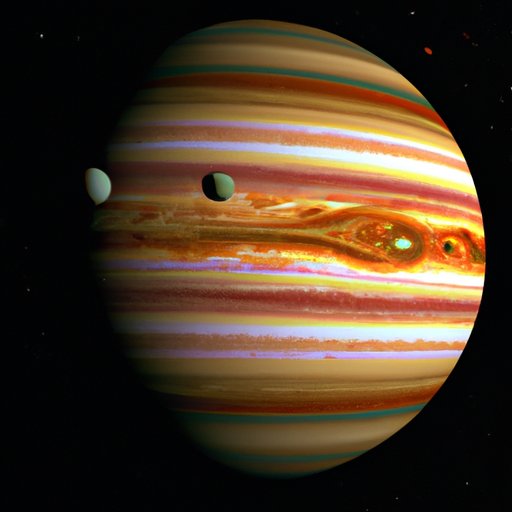Introduction
One of the most asked questions about our solar system is which planet is the largest. While it seems like a straightforward question, the answer can be more nuanced than expected. This article aims to provide an overview of the largest planet in our solar system and explore why it is important to study it. We will take a closer look at Jupiter – the “king” of planets – and its physical characteristics, its role in the formation and development of our solar system, as well as what we can learn by studying it.
A Brief Guide to the Largest Planet in Our Solar System
Before delving into the specifics of Jupiter, we need to define what we mean by “largest planet.” Generally speaking, the size of a planet can be determined by its diameter, mass, or volume. For this article, we will be focusing on the planet’s diameter – the distance from one side of the planet to another side passing through its center.
The largest planet in our solar system is Jupiter. It has a diameter of approximately 86,881 miles (139,822 kilometers), making it more than 11 times larger than Earth and the largest planet in the solar system.
Jupiter: The King of the Planets
Jupter is often dubbed as the “king” of planets due to its massive size and broad influence in our solar system. It is located fifth from the sun and is the fourth brightest object in the sky after the sun, the moon, and Venus.
One of the unique qualities of Jupiter is that it is predominantly composed of gas and does not have a solid surface like Earth. It is mainly made up of hydrogen and helium gas and has a rocky core that is believed to be at least 20 times the mass of Earth.
Jupiter is known for its Great Red Spot, a gigantic storm located in its atmosphere that is twice the size of Earth and has been raging for over 350 years. The planet also experiences extreme weather conditions such as lightning storms and high-velocity winds that can reach up to 384 miles (618 kilometers) per hour.
Exploring Jupiter: What Makes it the Largest Planet?
There are a few factors that contribute to Jupiter’s size. One of these is its composition – Jupiter’s primarily gaseous nature allows it to attract and hold onto a significant amount of fluid. Its large mass also means that it has a strong gravitational pull, which ultimately pulls in more gas and extends its size even further.
Another factor is how Jupiter formed. According to scientists, Jupiter likely formed in a similar fashion to a star, with a dense, hot core that attracted and compressed gas around it, causing it to grow. Some theories suggest that Jupiter may have even formed before the sun did.
Finally, it is worth noting that Jupiter’s many moons also contribute to its overall size. Jupiter has more than 80 moons, with the four largest known as the Galilean moons (Io, Europa, Ganymede, and Callisto). These moons are particularly large and heavy, and their gravitational influence further extends Jupiter’s sphere of influence.
Size Isn’t Everything: Why Jupiter Is Still an Important Planet to Study
While Jupiter’s massive size is certainly impressive, there are many other reasons why studying this planet is important. Firstly, Jupiter played a significant role in the formation of our solar system. Understanding the planet can give us insights into the conditions that existed during that time, as well as how our solar system came to be.
In addition, Jupiter’s gravity has a significant impact on the other planets in our solar system. Its gravitational pull affects the orbits of other planets and helps maintain stability in the solar system. Studying Jupiter can also help us understand other gas giants in our solar system and beyond.
The Stunning Beauty and Power of Jupiter, the Largest Planet in the Solar System
Not only is Jupiter important to study, but it is also incredibly beautiful. Space probes like the Juno spacecraft have captured breathtaking images of the planet, revealing its intricate weather patterns and natural wonders. Some of these include Jupiter’s auroras, storms, and its iconic Great Red Spot.
These natural wonders all contribute to Jupiter’s incredible power and influence in the solar system. Studying them can help us better understand the processes by which planets form and evolve and can give us insights into the broader universe beyond our tiny planet.
Jupiter’s Role in Our Solar System: What We Can Learn from the Giant Planet
There are many ongoing and upcoming missions to study Jupiter and its moons. The Juno spacecraft, launched in 2011, has been orbiting the planet since 2016 and has already provided important insights into the planet’s atmosphere and magnetic field. In 2024, the European Space Agency plans to launch the JUpiter ICy moons Explorer (JUICE) mission, which will explore the Galilean moons in more depth and learn more about their composition and structure.
There is still much to learn about Jupiter, and scientists are excited to continue exploring this giant planet and unlocking its many secrets. Understanding what we can learn from the planet is key to furthering our knowledge of our solar system and the broader universe beyond it.
Unveiling the Secrets of Jupiter, the Largest Gas Giant in Our Solar System
In conclusion, Jupiter is the largest planet in our solar system and has numerous fascinating characteristics that make it worth studying. Its massive size and strong gravitational pull have contributed significantly to the formation and development of the solar system, making it an important object of study for scientists and researchers alike.
The more we learn about Jupiter, the more we can understand our place in the universe beyond our tiny planet. As technology continues to advance, we can uncover more of the secrets hidden within the king of planets and continue to expand our understanding of our solar system and beyond.
